Coordinating crews across job sites is a daily battle. Miss one shift handoff or double-book a foreman and the whole schedule slips. For superintendents and project managers juggling dozens of moving parts, the old ways—whiteboards, spreadsheets, walkie-talkies—fall short.
That’s where manpower scheduling software for construction makes a real difference. It lets you track every crew member, plan ahead without guesswork, and adjust on the fly when things shift. The best tools don’t just handle the schedule—they tie into broader construction field service management systems that connect your office, field, and dispatch teams in one view.
Here’s what we’re breaking down in this guide:
- How to choose construction manpower scheduling software
- 5 key features in manpower scheduling software for construction teams
- Best manpower scheduling software for commercial construction
- Best for residential contractors
- Best general contractors
- Other notable manpower scheduling tools for construction
- 7 benefits of construction crew scheduling software
- 5 construction manpower scheduling software FAQs
Before we dive into the top software picks, let’s talk about how to figure out what your team actually needs—and what to look for when choosing the right manpower scheduling tool.
How to choose construction manpower scheduling software
Scheduling labor on a construction site means managing timing, crew availability, and shifting job site priorities—all while keeping projects on track. A commercial contractor balancing multi-phase builds has different needs than a residential crew juggling tight turnarounds. How your operation runs day to day should guide the type of software you use.
Manpower scheduling software for construction needs to match how your team moves. The best platforms let you adjust schedules fast, view team availability across sites, and coordinate without chasing updates. Many crews also plug their workforce planning into broader construction scheduling software to line up labor, materials, and tasks in one place.
Here are some key factors to think about when choosing your setup:
- Job type and project scope – Do you run long-term commercial builds or short, high-volume projects? Are your crews working across multiple sites? How often do schedules shift during a typical week?
- Team size – How many workers do you need to manage? Are you handling one crew at a time or coordinating across dozens? Do you need tiered access for field leads, supervisors, or dispatchers?
- Crew specialization – Are your workers interchangeable across tasks, or do certain jobs require specific licenses or certifications? Do you need to schedule based on skill sets or equipment availability?
- Support and training – Does the vendor offer onboarding support? Can your team learn it quickly? What kind of help is available when something breaks or gets missed?
- Features – Can you filter by job site, role, or shift length? Does it support drag-and-drop rescheduling or mobile check-ins? Are the tools easy to use in the field?
Once you’ve nailed down what your team needs, it’s time to look at what the software can actually do. Features matter—especially when your day depends on fast decisions and clear crew visibility. Let’s break down the core functions that make construction manpower scheduling software worth using on real job sites.
5 key features in manpower scheduling software for construction teams
The job site throws curveballs daily. One missed delivery, one crew delay, and suddenly your entire schedule’s off balance. That’s why manpower scheduling software for construction can’t just track shifts—it needs to sync everyone from dispatch to the job site in real time.
Let’s say you’re running a plumbing crew across three active sites. One project’s inspection gets pushed, another crew finishes early, and you’ve got a foreman juggling calls while trying to lay pipe. With construction manpower scheduling software, your back office can adjust crew assignments, field techs can view updates on their phones, and nobody’s left guessing.
Here are five features that keep your field service operation running smooth—even when the ground shifts beneath your boots.
1. Real-time dispatch board
You can’t wait until tomorrow to move crews when timelines shift mid-day. A live dispatch board gives your office staff a clear, drag-and-drop view of where every tech is and what’s next on the docket. Field leads get instant updates, and the risk of overbooking or double-assigning disappears.
For instance, your rebar team finishes a basement pour ahead of schedule—your dispatcher can reroute them straight to another site without missing a beat. With construction dispatching software, that move happens in seconds, not hours, keeping your manpower where it’s needed most.
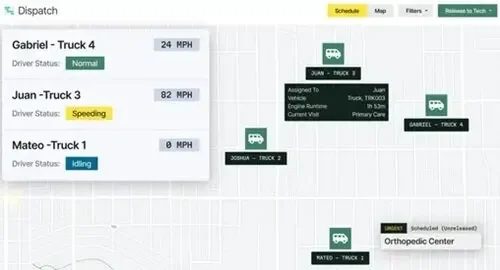
Try our dispatching product
Get more jobs done by sending the right tech to the right job site—every time.
2. Field technician mobile access
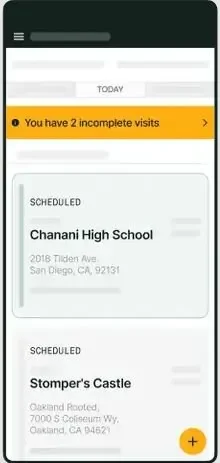
Updates sent to a whiteboard don’t help when your crew’s in the field. A mobile interface built for field techs closes the loop between dispatch and boots on the ground. Crews see where they’re headed next, job details, contacts, and notes—right from their phones.
Let’s say a tech just wrapped up drain line trenching at Site A. Before hopping in the truck, they check the app and see they’ve been reassigned to emergency service at Site B. No confusion, no delays. Using a technician mobile app, your team stays one step ahead, even when the schedule shifts mid-shift.
3. Customer and job history tracking
When you know the history of every job, every technician, and every delay—you schedule smarter. A construction CRM keeps track of what’s been done, who handled it, and what’s next. That context matters when you’re reassigning workers or juggling overlapping tasks.
Picture this: your drywall crew shows up and sees the electrical work’s not done. With access to construction CRM tools, your foreman can instantly check job notes, contact the site lead, and shuffle tasks while keeping everything on record.
4. Integrated quoting tools
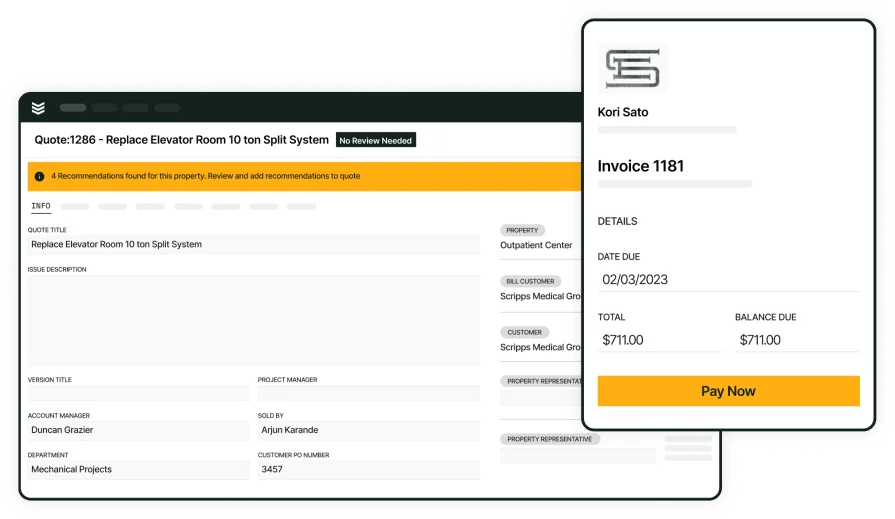
Fast schedules need fast quotes. The sooner you price out labor and get it approved, the sooner you can line up the crew. Quoting software lets your office price, send, and convert estimates into scheduled jobs without re-entering a thing. Say a contractor calls asking for a change order to add trenchless sewer repair.
With construction quoting software, your office can shoot over a new estimate while the original crew is still on-site—then assign them the added task if it’s greenlit, all from the same dashboard.
5. Fleet visibility and coordination
Even the best crew schedule falls apart if your trucks and gear aren’t where they need to be. Fleet tracking tools show where vehicles are, what’s in them, and when they’re available. This is key when your manpower planning depends on shared equipment.
Here’s a real-world example: your excavation team finishes early, but the trench box is with another crew across town. With fleet management software, your dispatcher reroutes the truck carrying it, keeping the next site on schedule and minimizing rental delays.
Other valuable manpower scheduling features for construction teams
Strong scheduling is just one part of the puzzle. To keep projects moving, construction businesses also rely on tools that simplify reporting, automate billing, and create accurate documentation from the field. These features aren’t always front and center in scheduling platforms, but they’re essential for a smoother handoff between office and job site.
Here are three more tools that work hand-in-hand with construction manpower scheduling software:
- Invoicing and payment solutions – Once the job’s done, billing and collections should be just as streamlined as dispatch. Integrated field service invoicing tools and payment solutions let your back office generate invoices directly from job data and accept payments without switching platforms. Crews log work hours and task completions, while admins send accurate bills and get paid faster—all tied back to your scheduling system to avoid errors or delays.
- Job cost reporting – Knowing how much time, labor, and materials a project consumed is critical for future estimates and profitability. Construction analytics & reporting tools give you a clear look at actual vs. planned costs, technician productivity, and task completion timelines. These reports help PMs and owners understand where the budget held and where it didn’t—so future bids get sharper.
- Time tracking integration – Syncing timesheets with your manpower schedule keeps payroll accurate and reduces the back-and-forth between supervisors and admin staff. With time tracking tools for field service techs, crews log hours directly from the field, and office teams can easily verify work durations without chasing down paper logs.
Now that we’ve covered the features that power smarter scheduling, it’s time to look at the actual tools on the market. Some platforms are built for large-scale commercial operations, while others fit tighter crews or specialty contractors. Let’s break down which options deliver when it comes to managing labor with manpower scheduling software construction teams rely on.
Best manpower scheduling software for commercial construction: BuildOps

BuildOps delivers commercial construction teams the horsepower they need to manage complex schedules across multiple projects. It features a drag-and-drop scheduling interface that makes it easy to assign crews by skill set, location, or job priority. From the office to the job site, real-time updates keep everyone on the same page. Built-in filtering, visual layouts, and mobile sync mean your PMs aren’t guessing who’s free—they see it.
How Pricing Works: BuildOps offers live weekly demos and customized sessions to walk teams through the features that match their workflows.
Features Beyond Scheduling: Real-time dispatching, skill-based filtering, CRM syncing, time tracking, quoting, mobile access, invoicing, payments.
What Sets It Apart for Commercial: BuildOps connects manpower scheduling with every part of your field operation—quoting, job tracking, invoicing, and more—all in one platform.
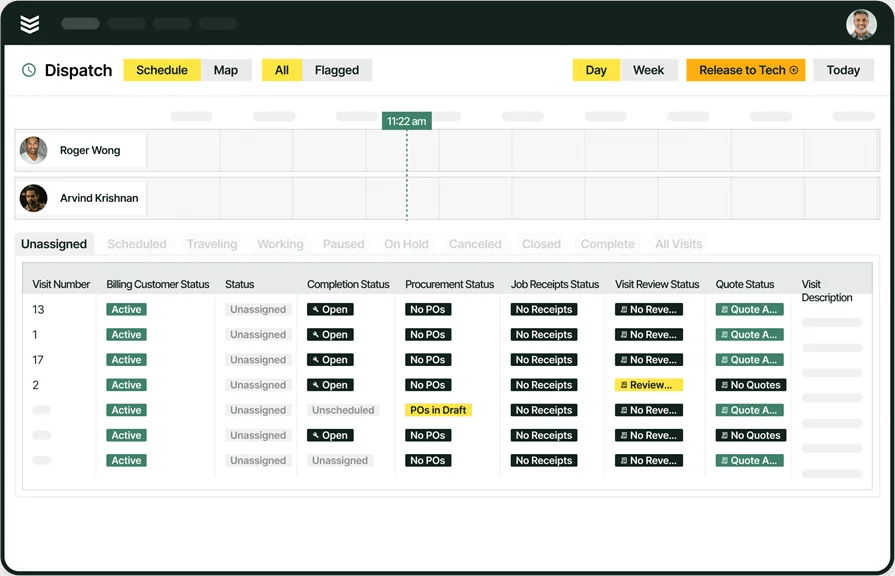
Give BuildOps a Try
See how BuildOps supports crews from dispatch to job closeout.
Best for residential contractors: Fieldwire

Image Source: Fieldwire
Fieldwire works well for residential builders looking to keep daily schedules tight across multiple small jobs. It features daily task lists, crew assignments, and jobsite visibility from a centralized calendar. The platform supports Gantt chart views and real-time updates between field and office, making it easier to coordinate subcontractors and shift tasks as needed. However, its focus on task management over labor planning means it may fall short for teams needing advanced crew-level visibility across larger workloads.
How Pricing Works: Tiered pricing; free version available with limited features.
Features Beyond Scheduling: Blueprint markups, punch lists, progress tracking, and mobile task management.
What Sets It Apart for Residential: Designed with site-level planning in mind, Fieldwire helps residential teams simplify coordination across trades and keep smaller-scale projects moving.
Best for general contractors: Connecteam

Image Source: Connecteam
Connecteam offers a simple, mobile-friendly scheduling platform built for general contractors who manage distributed field crews. It supports shift scheduling, time tracking, task assignments, and internal communication all from one dashboard. The app also helps streamline attendance and automates reminders so supervisors aren’t chasing down updates. That said, its feature set may feel limited for companies managing larger jobs, multiple subcontractors, or advanced dispatching needs.
How Pricing Works: Monthly per-user plans; free version available with basic tools.
Features Beyond Scheduling: Time clocks, job checklists, internal chat, safety forms, mobile document storage.
What Sets It Apart for General Contractors: Its strength is flexibility—Connecteam helps GCs keep small to mid-size field teams aligned without needing extra software for communication or compliance.
Other notable manpower scheduling tools for construction
Not every crew runs the same kind of jobs, and not every tool fits the same kind of team. While some platforms shine in commercial work or daily dispatching, others are better suited for builders who need visibility across a full project timeline. If you’re still weighing options, these additional construction manpower scheduling software solutions are worth exploring.
Procore
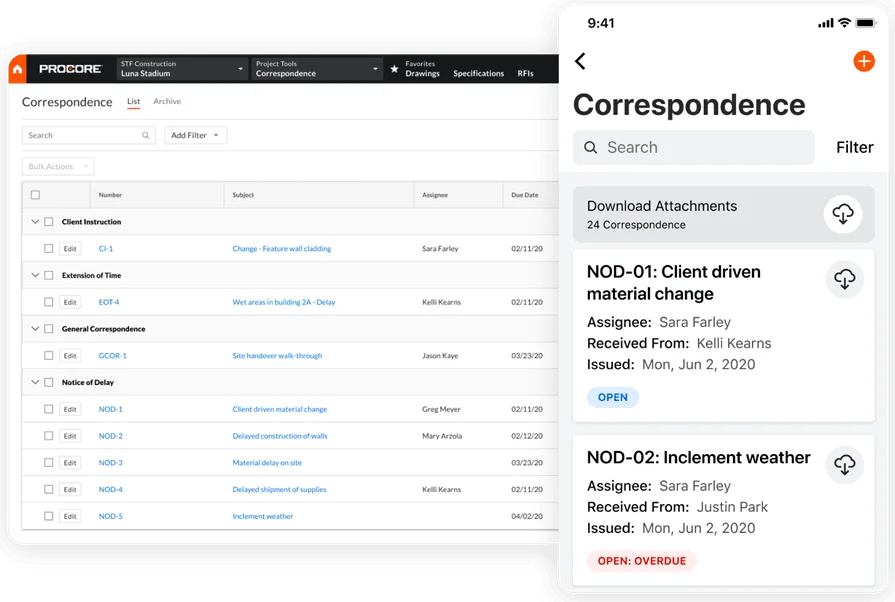
Image Source: Procore
Procore’s scheduling module integrates directly into its broader construction project management suite. It helps GCs and subcontractors build and adjust schedules, track manpower needs, and share timelines with teams and stakeholders. The Gantt-style layout supports sequencing and dependencies, which makes it easier to understand how one change affects the whole job. But its steep learning curve and high implementation cost may be overkill for smaller contractors focused purely on labor scheduling.
How Pricing Works: Custom quotes based on company size and modules selected.
Features Beyond Scheduling: RFIs, drawings, budgeting, quality & safety tools, document management.
What Sets It Apart: Procore combines manpower scheduling with end-to-end project controls for teams managing large-scale, multi-phase builds.
Outbuild
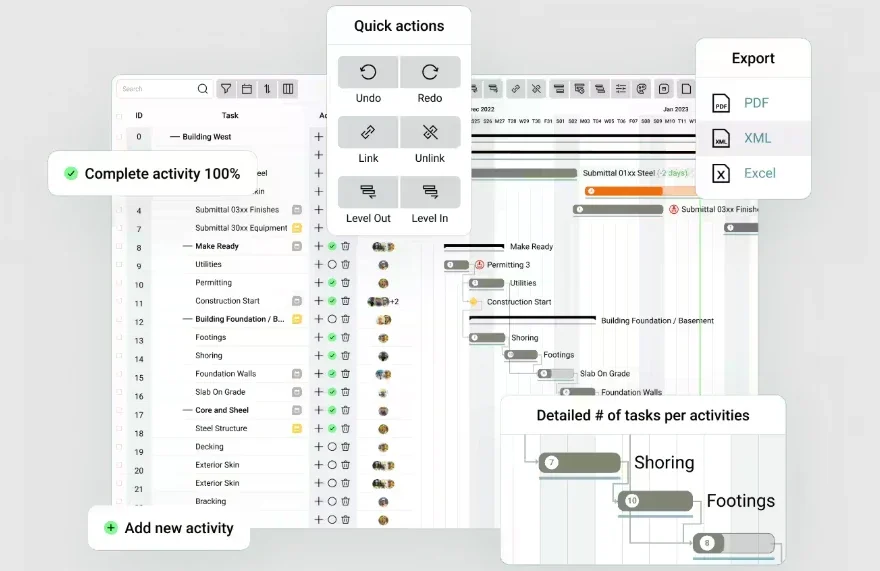
Image Source: Outbuild
Outbuild offers simple, visual scheduling designed to keep field teams aligned with production goals. Crews can view daily and weekly task assignments, mark completions, and report delays—all in one place. It's designed for use in lean construction workflows and integrates with pull planning methods. Still, it may not include deeper backend tools like invoicing, CRM, or time tracking, which some contractors expect alongside scheduling.
How Pricing Works: Per project or per user pricing; details available upon request.
Features Beyond Scheduling: Look-ahead planning, task tracking, PDF exports, collaborative workflows.
What Sets It Apart: Focused on field-level planning, Outbuild helps project teams coordinate manpower and productivity using short interval scheduling methods.
Autodesk Construction Cloud
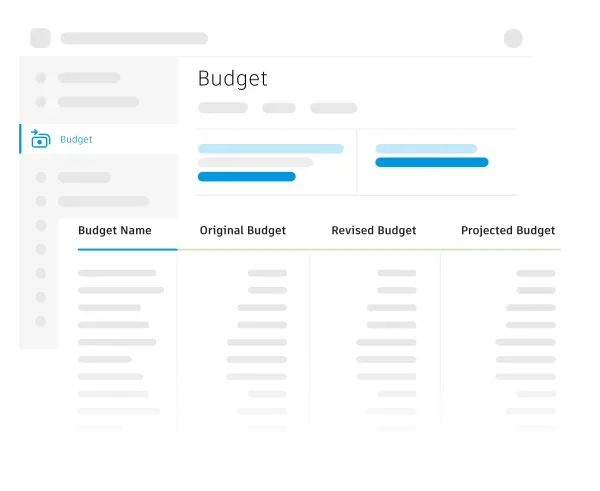
Image Source: Autodesk Build
Autodesk’s scheduling tools give contractors a high-level view of project sequencing across teams and trades. The platform allows users to link schedules to BIM data, visualize timelines in 3D, and track how site work aligns with planned phases. It’s ideal for coordination across large, detail-heavy builds.
How Pricing Works: Enterprise-level pricing; requires demo and consultation.
Features Beyond Scheduling: BIM integration, RFIs, submittals, cost management, document control.
What Sets It Apart: Its strength is deep integration between scheduling and design data, giving project teams visibility down to the model level. However, that BIM-centric focus may be unnecessary for smaller contractors or teams that don’t rely on Autodesk’s broader design ecosystem.
Buildxact
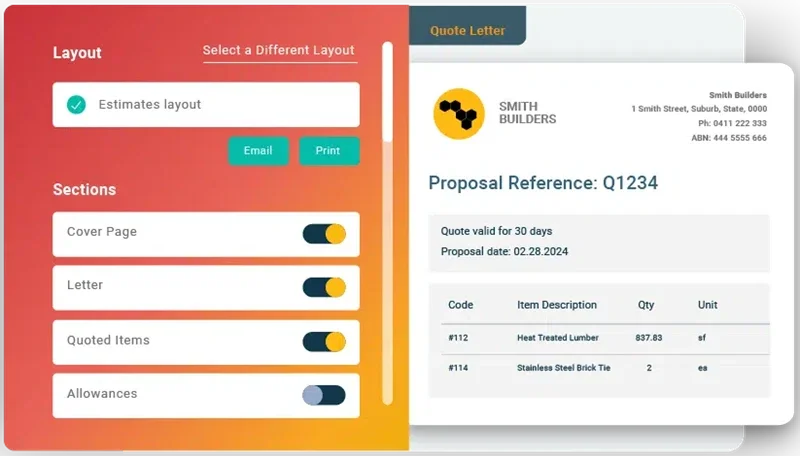
Image Source: Buildxact
Buildxact simplifies scheduling for residential builders and remodelers with drag-and-drop timelines, Gantt charts, and job templates. Users can assign tasks to crews and subcontractors while automatically linking schedule changes to quotes and material orders. Still, the platform’s feature set may feel limited for larger teams or contractors needing detailed labor tracking or dispatch workflows.
How Pricing Works: Monthly subscription with tiered plans based on features.
Features Beyond Scheduling: Estimating, takeoffs, invoicing, purchase orders, client communication.
What Sets It Apart: Its strength lies in combining estimating and scheduling, which helps smaller contractors turn quotes into scheduled projects quickly.
Buildern

Image Source: Buildern
Buildern offers an intuitive platform for builders looking to manage job schedules, tasks, and timelines all in one place. It includes visual calendars, subcontractor coordination, and built-in notifications to keep field and office staff aligned. But for contractors juggling large-scale jobs or multi-crew shifts across sites, Buildern may lack the deeper filtering and dispatching tools needed to manage complexity.
How Pricing Works: Monthly or annual plans; pricing varies by user count and modules.
Features Beyond Scheduling: Budgeting, purchase orders, client access, daily logs, and time tracking.
What Sets It Apart: Buildern focuses on usability, making it a solid option for small to mid-size teams that need simple, clear construction manpower scheduling software.

Compare tools on the market
Guide yourself through the comparison process so you can find the right fit.
7 benefits of construction crew scheduling software
Construction doesn’t slow down to let you catch up. With so many moving parts—labor, timelines, delays—keeping crews aligned is what makes or breaks a job. That’s where construction manpower scheduling software delivers real impact, giving teams in the field and office the tools to work faster, communicate better, and stay one step ahead.
1. Faster reaction time on the job
Jobsite delays are unavoidable. But how fast you respond is what matters. When your crew scheduling tool can reassign workers and shift jobs in real time, you reduce lost hours and stay on track. That kind of responsiveness is built into solid field service scheduling systems that allow for fast adjustments as conditions change on site.
2. Centralized jobsite data and communication
When scheduling connects directly with project documentation, you don’t waste time chasing updates. Field supervisors, PMs, and office staff see the same task progress, delays, or checklists from one platform. This works especially well when scheduling integrates with a construction field report app that logs jobsite activity alongside labor assignments.
3. Better workforce forecasting
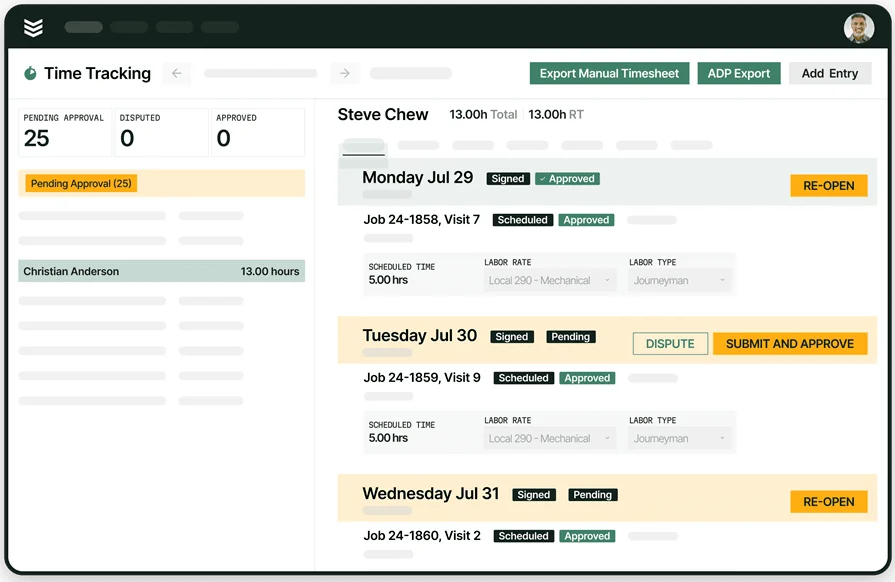
Past schedules show you how labor was used—future schedules help you do it better. Tracking who worked where and when reveals patterns you can use to staff smarter. Larger GCs often roll these insights into commercial construction project management workflows to plan ahead without overbooking or leaving crews idle.
4. Cleaner customer communication
Scheduling software that syncs with a CRM for construction improves how you keep clients in the loop. Your team can confirm crew availability, send progress updates, or adjust timelines based on actual field status—all without cross-referencing five different spreadsheets or email chains.
5. Fewer missed assignments and overlaps
When schedules are managed manually, crews get double-booked or left off the calendar entirely. Crew scheduling software removes that guesswork by showing clear visual availability, shift overlaps, and gaps in coverage. It's a simple fix that eliminates the daily scheduling scramble.
6. Stronger job accountability
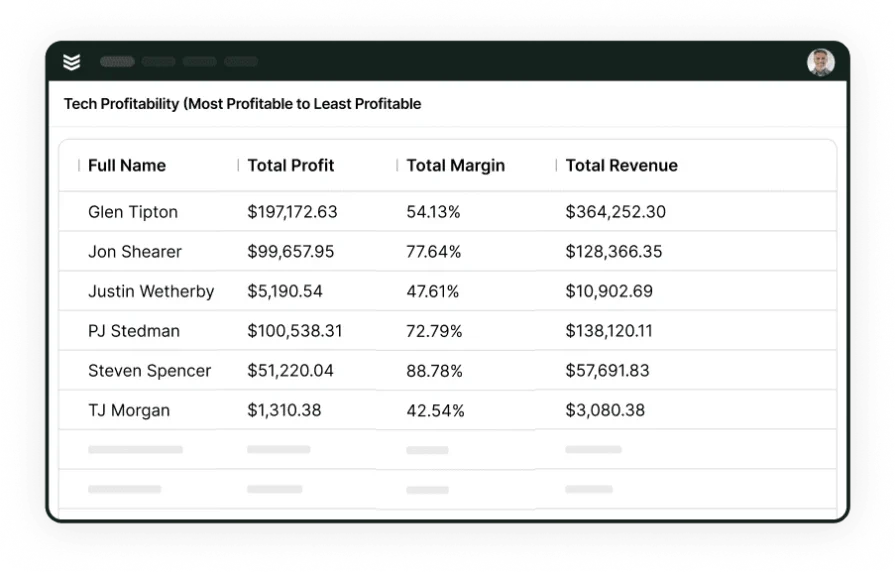
A transparent labor schedule backed by timestamps gives you a full audit trail. You’ll know who was assigned where, for how long, and what was completed. That visibility helps resolve disputes, validate billable hours, and track performance site to site.
7. Smart scheduling backed by construction AI
Some platforms go beyond tracking and start making decisions. With construction AI built into scheduling, the software can recommend labor adjustments, flag inefficiencies, or even predict when certain tasks might run over—based on how your team has worked in the past.

Unlock real-world strategies
Learn how to leverage AI to increase productivity and eliminate booking conflicts.
5 construction manpower scheduling software FAQs
Still deciding if construction manpower scheduling software is the right fit for your team? These FAQs answer the most common questions from field contractors, project managers, and business owners trying to solve crew coordination headaches and schedule-related delays.
1. What is construction manpower scheduling software?
Construction manpower scheduling software helps contractors plan, assign, and adjust their labor schedules in real time. It allows field and office teams to track who’s working where, what’s been completed, and what needs to shift—without relying on spreadsheets or manual coordination between teams.
This kind of platform often connects with dispatch, time tracking, and project reporting systems so that scheduling decisions are made with live data—not outdated files. Some tools also sync with CRM and job costing tools to centralize planning even further.
2. How do manpower construction scheduling programs work?
Most construction scheduling programs give dispatchers or supervisors a centralized dashboard to view, assign, and manage labor. You can build schedules, drag and drop crews into shifts, and make real-time updates as job needs change. Field techs often get notified via mobile apps so they can adjust quickly. Many platforms also track time, send alerts, and integrate with other project management tools so that everything flows without double entry.
3. How much does construction manpower scheduling software cost?
Pricing varies widely depending on your team size, project volume, and which tools are included. Here's a breakdown of the most common pricing tiers:
- Per-user monthly subscriptions ($20–$75/user/month) – Best for small teams who need basic scheduling and time tracking without extra modules.
- Tiered packages based on features and user count ($100–$300/month) – Ideal for mid-size contractors who need dispatch, reporting, CRM sync, and mobile access.
- Custom enterprise pricing (starts at $500/month and up) – For large-scale operations needing deep integrations, customer support, and enterprise-level control.
Many providers also offer free trials or demos to help teams assess fit before committing.
4. Who needs to use automated construction manpower scheduling software?
Any construction team juggling multiple sites, tight timelines, or unpredictable labor availability benefits from automating scheduling. Here are some common scenarios:
- Contractors still using spreadsheets or whiteboards to manage crew assignments
- Field teams who rely on phone calls or texts to get schedule updates
- Companies struggling with overlapping shifts or missed jobsite coverage
- Operations scaling across multiple regions or high-volume jobs
- Crews frequently reassigned based on shifting project needs or emergencies
Automation doesn’t replace the scheduler—it gives them a better set of tools to manage chaos.
5. What are some best practices for using construction manpower scheduling software?
To get the most out of your scheduling tool, it’s important to build good habits into your workflow. These best practices help teams stay accurate, efficient, and flexible:
- Assign crew roles based on real qualifications, not just availability
- Keep contact details and certifications up to date for every crew member
- Use real-time alerts to notify teams of changes instead of relying on call chains
- Sync schedules with time tracking to verify attendance automatically
- Build reusable schedule templates for repetitive or phased jobs
- Set clear access levels for dispatch, supervisors, and field techs
- Regularly review reports to spot patterns in crew utilization and overbooking
- Connect your schedule with job costing and field reporting tools to centralize planning
In construction, time is never just time—it’s labor, money, and reputation. If your crew’s schedule slips, your whole project does too. That’s why the shift toward smarter, automated manpower scheduling isn’t just a tech upgrade—it’s how modern contractors keep pace with a fast-moving jobsite.
Whether you're managing five people or fifty, the goal stays the same: get the right crew, to the right site, at the right time. And while there’s no shortage of tools on the market, the best ones are built to handle the real field conditions—tight timelines, shifting crews, and the unexpected.
For commercial contractors who need a scheduling tool that ties into dispatch, time tracking, CRM, and job reporting, platforms like BuildOps stand out as true all-in-one solutions. But no matter what system you’re leaning toward, the win comes from giving your team more control over the chaos, not less.
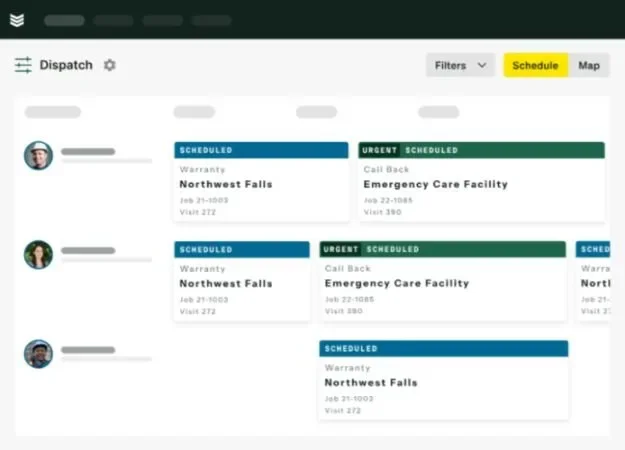
See BuildOps in action
Get jobs done faster by making sure crews time is managed effectively.






